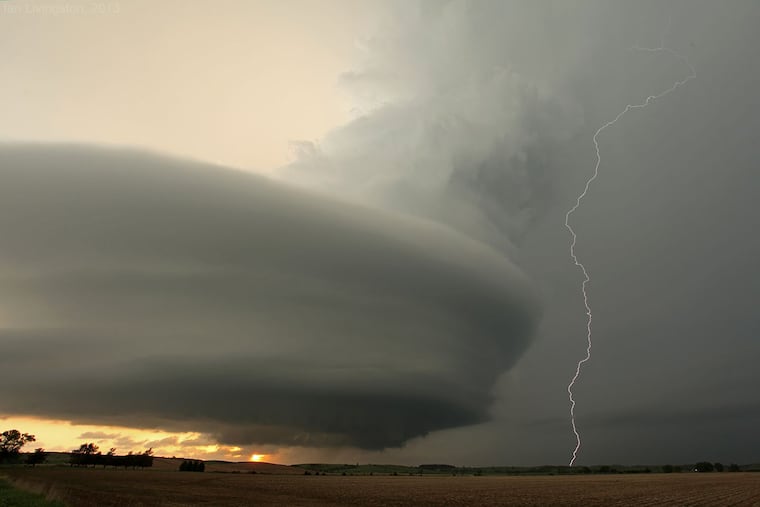‘Mr. Tornado,’ in one of history’s greatest detective feats, measured the immeasurable
"Ted" Fujita, who invented the ranking scale of tornadoes, is the subject of a PBS documentary airing Tuesday night.

By the time the most powerful tornado in Pennsylvania’s history completed its terrifying 47-mile journey, 18 people were dead, over 300 were injured, and 100 buildings had been leveled.
The peak wind speeds far exceeded the measuring limits of any weather instrument; anemometers weren’t much use above 100 mph. Yet the National Weather Service was able to declare confidently that the winds were better than 260 mph — an F5 tornado.
That had everything to do with the extraordinary detective work of Tetsuya “Ted” Fujita. He is the “F” in the tornado-intensity scale, which he developed by taking, and analyzing, thousands of damage photographs and inferring wind speeds.
» READ MORE: Under the radar, tornado season already the deadliest since 2011; twister confirmed in N.J.
Fujita, who died in 1998, is the subject of a PBS documentary, Mr. Tornado, which will air at 9 p.m. Tuesday on WHYY-TV, 12 days shy of the 35th anniversary of that Pennsylvania F5 during one of the deadliest tornado outbreaks in U.S. history. (The program will follow a Nova segment on the deadliest, which occurred in 2011.)
Some of the documentary’s archival tornado footage is frightfully breathtaking; more significantly, the program adds flesh to a figure whose name — like those of Charles Richter (earthquakes) and Herbert Saffir and Robert Simpson (hurricanes) — is forever associated with a number.
» READ MORE: Utterly unreasonable behavior of the atmosphere in 2011
Viewers will learn that Fujita not only had a voracious appetite for tedium and detail, he evidently had a tapeworm.
One man’s obsession
A Pennsylvania State University professor named Greg Forbes was astounded at what nature had wreaked on May 31, 1985. Forbes was part of the post-storm forensic team, and he recalled last week that he was awed when he saw that a tornado had “crushed or rolled several huge petroleum storage tanks.”
At his recommendation, the National Weather Service declared it an F5. Forbes knew the drill; he had participated in landmark tornado-surveillance projects while a graduate student under Fujita at the University of Chicago.
» READ MORE: Catch the wind ... at 200 m.p.h.
Fujita, who became a U.S. citizen, was part of a Japanese research team that examined the nuclear destruction of Hiroshima and Nagasaki in 1945. He observed damage patterns that were similar to those he would encounter after tornadoes.
While Fujita was trained as an engineer, he had an intense interest in meteorology, particularly thunderstorms. Forbes, who went on to become a fixture at the Weather Channel, recalled that Fujita came across a discarded thunderstorm study by Chicago’s Horace Byers. Fujita purchased a typewriter with English characters and sent a copy of his own study to Byers, who invited him to Chicago.
The United States is a battleground of air masses and a world capital of tornadoes, and they fired Fujita’s passion.
His first forensic foray was a two-year post-storm analysis of a massive tornado — one that lasted for six hours, with cloud tops 75,000 feet into the atmosphere — that struck Fargo, N.D., on June 20, 1957. From witnesses, he was able to obtain about 200 photographs, but he decided it would be better to take his own pictures.
He started chartering Cessnas for low-flying surveillance of tornado aftermaths and built a collection of thousands of photographs from which he was able to infer wind speeds, thus creating the Fujita Scale.
About the F Scale
The 1996 movie Twister begins with a scene in which a family scurries to a storm shelter as a tornado approaches in June 1969. The father is heard saying, “TV says it’s big, … maybe an F5.” That would have been news to Fujita in 1969. He did not publish his ranking scale until 1971, and the National Weather Service didn’t begin using it officially until 1973.
Seventeen years after the Fargo twister, Fujita undertook a major examination of the aftermath of what was then the worst tornado outbreak on record. Across 13 states, tornadoes killed 315 people on April 3 and 4, 1974, with 148 twisters causing damage over 2,500 miles of paths. His aerial surveys covered over 10,000 miles.
When the investigation was completed, Fujita produced a hand-drawn map with the tornado paths, complete with his F Scale numbers.
Enhancing the F Scale
No device ever has measured tornado wind speeds directly at the surface.
The Fujita Scale wasn’t perfect. Chet Henricksen, while in charge of the Mount Holly weather service office in 1994, questioned whether a July tornado that killed three people in Montgomery County was an F3, which could have winds up to 206 mph.
“Several technical articles suggest that wind speeds associated with some descriptions of damage are too high,” the weather service said in a 2004 report. Fujita himself had acknowledged that his scale needed editing.
Forbes was part of a committee of engineers and meteorologists who adjusted the scale to account for a range of buildings and other objects.
The weather service published an “Enhanced Fujita Scale” in 2007, which tweaks the values for all six levels of winds, EF0 through EF5. An F0 could have winds as low as 40 mph, but it would have to have at least 65 mph to make it as an EF0. While Fujita’s F5 threshold was 261 mph with an upper limit of 318 mph, the EF5′s is 200 mph and above.
But in measuring the immeasurable, Fujita made an immeasurable contribution, Forbes said. Before Fujita, he said, according to some encyclopedias tornado winds “could reach 500 mph or even the speed of sound.”